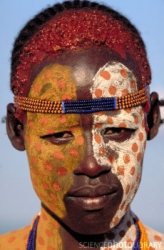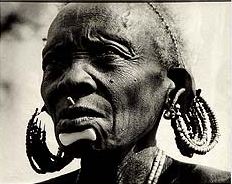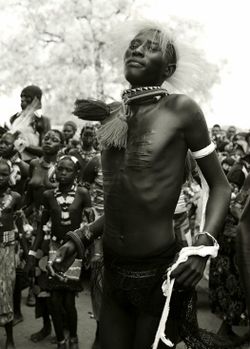مورلى (شعب)
المورله Murle، جماعة عرقية تعيش في مقاطعة پيبور، ولاية جونگليْ، جنوب السودان، وبعض مناطق إثيوپيا. ويشار للمورله لدى شعوب الدنكا وبعض الجماعات العرقية الأخرى باسم البير.
الثقافة
المذابح
في معظم ثقافات تربية البقر في جنوب السودان، فإن المهور والضرائب العشوائية التي يفرضها الحكام المحليين يحفزون الشبان لإيجاد أعذار لسرقة المواشي من أبناء عمومتهم. لذا يحاول الزعماء المحليون أحياناً الحد من القتال داخل القبيلة نفسها، بأن يأمروا المعتدين بمغادرة القبيلة ليقيموا مع قبائل أخرى. كما أن المورلى، كما تراهم القبائل المجاورة الأقوى منهم، هم شعب بدائي يملك قوى سحرية هائلة، ولذلك فكثيراً ما تُعزى إليهم الأمراض غير المفهومة والسرقات والحرائق.
ولما كان جنوب السودان غارقاً في المدافع الرشاشة من حرب الشمال والجنوب، فإن "سرقة المواشي" كثيراً ما تخرج عن نطاق السيطرة، ويروح ضحيتها عشرات أو مئات الأشخاص ضربات تصعيد ثأري. ويعدد الكثير من النوير بأن المورلى هم أحفاد مهاجرين لم يكن لهم حقوق لاستخدام الأرض أو للرعي على الكلأ. ولذلك فإن مواشي المورلى، حسب تبرير النوير، تكبر على كلأ مسروق، ولذلك فإن معظم مواشي المورلى هي إما مسروقة من النوير أو أنها ترعى، بدون وجه حق، على مراعي النوير.
وعلى طول حدود جنوب السودان مع إثيوبيا، فقد نشب تمرد مسلح داخل المورلى وقد وجد العديد من المدنيين أنفسهم محصورون داخل هذا النزاع. [1] Civilians alleging torture by the Sudan People's Liberation Army (SPLA) claim fingernails been torn out, burning plastic bags dripped on children to make their parents hand over weapons and the villages of Laor and the Tanyang people burned alive in their huts because rebels were suspected of spending the night in the village.[1]
On august 18th 2011, Murle youngsters sacked and burned the air strip village of Pierri and a dozen surrounding hamlets, killing over a hundred people, abducting dozens or hundreds of children and stealing up to tens of thousands of cattle. [2]. One explanation might also be the drought: Pierri has one of the very few functioning dry season drinking water wells, often with thousands of people queuing for its water. Nuer have often excluded Murle from using this water.
Because Murle have very few people in the government or even speaking English, it is difficult for journalists and researchers to check any claims against the Murle.
Part of such conflicts can be prevented by sinking much more drinking water wells. Also a national conference on drinking water, land use rights and land redistribution, might help, if Murle survival needs and all their arguments are taken serious.
Also state intervention in bride wealth culture (moving it away from virtual slave trade to an exchange of intentions and nominal tokens) and strong state action against illegal taxation by local leaders in Nuer, Dinka and Murle society is needed.
Also, South-Sudan, with its enormous agricultural potential during the rainy season, needs to be connected to regional and world markets, so that through agriculture and cattle breeding, the economy can be based on something else then tit for tat theft.
انظر أيضاً
- ديڤد ياو ياو، قائد تمرد المورلى على حكومة وجيش جنوب السودان منذ 2013.
هوامش
- ^ أ ب "Sudan: Transcending tribe". Aljazeera.net/english, LLC. Retrieved 2011-04-30.
- ^ |title:South Sudan attacks 'leave 500 dead||date august 20 2011|http://www.bbc.co.uk/news/world-africa-14595368
المصادر
- Arensen, Jonathan E. 1982. Murle grammar. Occasional Papers in the Study of Sudanese Languages, 2. Juba: Summer Institute of Linguistics and University of Juba.
- Arensen, Jonathan E. 1983. Sticks and straw: Comparative house forms in southern Sudan and northern Kenya. International Museum of Cultures Publication, 13. Dallas: International Museum of Cultures.
- Arensen, Jonathan E. 1991. Aspects of language and society among the Murle of Sudan. D.Phil. thesis. Wolfson College, Oxford University.
- Arensen, Jonathan E. 1992. Mice are men: Language and society among the Murle of Sudan. International Museum of Cultures Publication, 27. Dallas: International Museum of Cultures.
- Arensen, Jonathan E. 1998. Murle categorization. In Gerrit Dimmendaal and Marco Last (eds.), Surmic languages and cultures, 181-218. Nilo-Saharan, 13. Cologne: R. Köppe.
- Lewis, B.A. 1972. The Murle: Red Chiefs and Black Commoners. Oxford University at the Clarendon Press.
- Payne, Thomas. 2006. Explaining Language Structures. Cambridge: Cambridge University Press.


